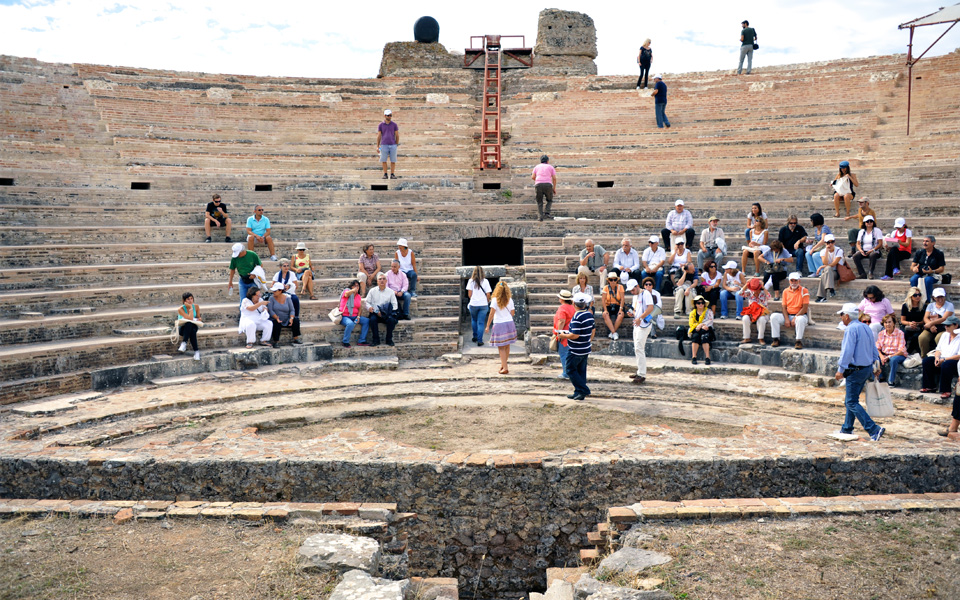Through the “Diazoma” initiative, citizens help Greece capitalize on ancient assets
Diazoma, a citizens’ platform aimed at protecting and promoting ancient Greek monuments, has come a long way since it was established in 2008 and is now looking to the future with reinforced confidence based on its winning combination of digital culture and entrepreneurship. This was the main line of thought expressed at the organization’s seventh general assembly, which took place recently in Kammena Vourla, Central Greece, as the broader geographical area came under the organization’s scrutiny.
“This year the focus is on entrepreneurship,” said Stavros Benos, the former culture minister who founded Diazoma as a citizens’ movement with the objective of benefiting the country as a whole. Diazoma has grown to such an extent that it is now helping to build synergies in the higher echelons of private initiative: From archaeologists and scientists through institutions, the initiative is promoting a development model for regions by focusing on ancient theaters as well as ways to connect culture, the environment, tourism, local societies and Greek and international networks. So far, the efforts have led to tangible results.
This is why this year’s assembly – the annual meetings tend to serve as mini-conferences for brainstorming between established scientists and young visionaries – focused on the future. The prevailing feeling among participants was that the country needs to be raised and to enter a period of growth.
“ From archaeologists and scientists through institutions, the initiative is promoting a development model for regions by focusing on ancient theaters as well as ways to connect culture, the environment, tourism, local societies and Greek and international networks.”

View from the proscenium
“Diazoma initiative is promoting a development model for regions by focusing on ancient theaters as well as ways to connect culture, the environment, tourism, local societies and Greek and international networks.”
At the meeting, Regional Governor of Central Greece Costas Bakoyiannis spoke of an “opening toward culture” and the idea of an organic connection between points of interest in different regions.
Diazoma completes restoration studies which are then presented to state officials, who in turn seek European funding for their realization.
It is worth pointing out that following the successful piloting of the initiative’s Cultural Itinerary for the Ancient Theaters of Epirus, a similar route was developed in the region of Central Greece. The developing network and the possibilities attached are not focused exclusively on archaeological landmarks, such as Delphi, but also around lesser-known archaeological areas, such as Eretria, Thebes, Chaeronea and Orchomenos, among others.
These ancient sites figure on a cultural map which is further enriched with more recent monuments, such as the Castle of Lamia, or beautiful landscapes, such as those of Evrytania. During the Diazoma officials’ four-day tour across Central Greece, the region demonstrated its potential as a tourist destination, an area capable of generating pride, emotion and wealth.

Ancient Gitana Theater
While the restoration project for the ancient Theater of Eretria is about to be submitted to the Central Archaeological Council (KAS), the impressive study regarding the development of the Archaeological Park of Orchomenos is based on Diazoma’s holistic approach – also reflected in the initiative’s Epidaurus project. This has to do with the fact that two of Greece’s leading archaeologists, professors Vassilis Lambrinoudakis and Petros Themelis, are core members of Diazoma.
The Orchomenos project – the city was one of the wealthiest in antiquity – was presented at the Athens Concert Hall to high acclaim. The trilogy of monuments located in the vicinity – a 13th-century tomb monument, a Hellenistic theater and the 9th-century Church of Panagia Skripou – are bound to change the broader area’s overall character and future. The study for the Orchomenos Archaeological Park was carried out by Pleias Architects, headed by Dimitris Diamantopoulos, while the theater’s restoration project was developed by Themis Billis and Maria Magnisali.









